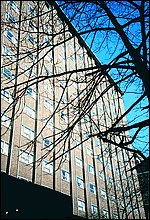 |
 |
 |
 |
|
AROUND THE QUADS Columbia
Dorms Meet or Exceed Fire Safety Codes
The deaths of three Seton Hall University students in a dorm fire in January has prompted a nation-wide examination of fire safety on college campuses. Columbia administrators say that the school meets or exceeds all fire safety regulations, but is reviewing its buildings and policies to look for areas where improvement is needed and taking steps to remedy weak spots already identified. Main factors in the Seton Hall deaths were reportedly lack of a sprinkler system, which keeps exit routes open, and students not leaving the building because they thought the alarm was false. Four dormitories on Morningside Heights - Carman, Hogan, Wien and Woodbridge - do not have sprinklers in their hallways. They are expected to be installed this summer at a cost of about $4 million, as part of the annual summer program of building maintenance and upgrading. Sprinklers are not required now, but a bill proposed in the New York state senate would require their installation in all campus dormitories within three years. "We feel that the dorms without sprinklers are safe, but an incident like Seton Hall makes an institution like Columbia take a close look and make sure we're doing everything in our power to make sure our students are safe," says Michael Van Biema, executive director in the office of administrative planning. Because the vast majority of alarms go off accidentally instead of for a real fire, students at Columbia are also reluctant to dash out of the building every time an alarm sounds. "I completely ignore fire alarms these days," a Furnald Hall resident confessed to Spectator. "I watch out my window to see if a crowd is gathering and people are pointing and if so, I'll leave." Last year there were about 180 fire alarms in the University's 17 residence halls. Nine of those went off because of an actual fire, and an equal number were false alarms where the alarm was pulled for no reason. "We generally get good compliance," with students evacuating buildings, Van Biema contends. "Right now, because everyone's awareness has been heightened [by the Seton Hall tragedy], we have better than usual." An e-mail sent to students by Ross Fraser, director of residence halls, following the Seton Hall fire emphasized that for their own safety, students must leave the building whenever a fire alarm sounds. Exceptions are for posted monthly alarm tests. Fraser said that his office heard from students' parents wanting to know the fire safety procedures and precautions in place at the school. Every dorm room has either a smoke detector or heat detector that is wired into a central alarm system and the fire department. Everyone is required to leave the building and the fire department comes each time a detector goes off. By special arrangement with the New York City Fire Department, every alarm that goes off at Columbia is responded to with three engine companies, two ladder companies and a battalion chief - that amounts to about 32 fire fighters and six vehicles. Alarms will ring continuously until inspected and re-set. Two of the nine fires last year were from clothes dryers overheating and igniting; the others were because of accidents like papers igniting in a trash can, according to Joe McCormick Jr., assistant director of the Office of Environmental Health and the university's former fire safety officer. The largest cause of unwarranted alarms is cooking smoke or steam, McCormick says. "The quickest response detector could be set off by hairspray or shower steam," he says. Near bathrooms, the university has changed to photoelectric smoke detectors that are less sensitive to steam, and in kitchens, heat detectors that measure a five-degree rise in heat within 60 seconds are replacing traditional smoke detectors. The construction of new or renovated dorms is class one fireproof, which means walls and doors should contain a fire within a room for an hour. Smoke, the leading cause of fire injuries, is not prevented from spreading, however. The average response time by the fire department is three to four minutes. "Everything is at least code compliant University-wide and is usually above and beyond," McCormick says. The most recent serious fires were in John Jay Hall in 1996-97, McCormick says. One was caused by an extension cord that overheated and ignited the room; the other was ruled "suspicious" and may have been set on purpose. In both cases the alarms worked and the fires were contained to the rooms where they started. Dorm policies allow smoking in designated rooms. Some items that commonly cause fires, like microwaves, hot plates, incense and candles, are forbidden but often used anyway. (Candles may be used for religious ceremonies or festivals with prior approval.) A task force has been formed to review the campus's residential policies, such as allowing the use of halogen lamps, which can cause fires and are currently discouraged, and will look for ways to improve fire safety and student awareness of precautions. Residential advisors are supposed to review fire precautions with students at the beginning of the school year, and many of them discuss fire prevention issues at floor meetings during the school year. McCormick frequently meets with student groups in dorms or those who work in labs and other especially fire-prone areas to review fire safety and sometimes practice using fire extinguishers. Last year, about 150 students attended "An Evening with Fireman Joe," an event in East Campus where McCormick discussed fire safety before and after the screening of two movies, 1,000 Wings and Backdraft.
|
|
||||||||||||||||||||||||||||||||||||||||||||||||||||||||||
